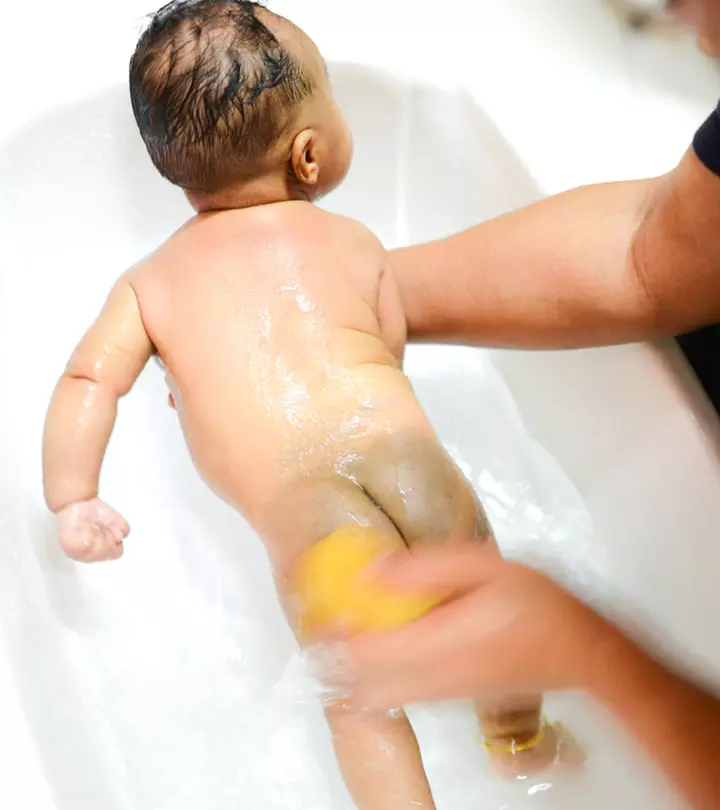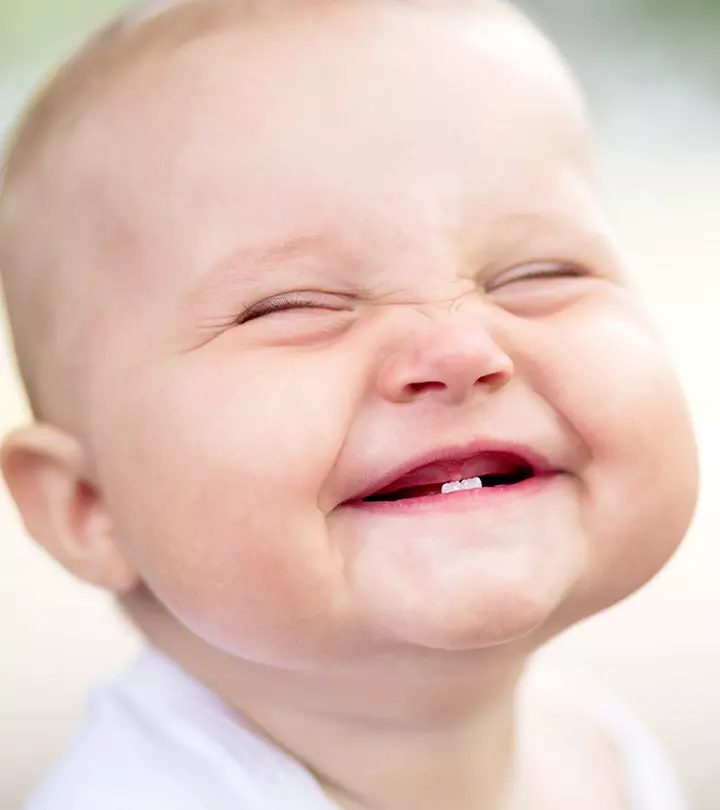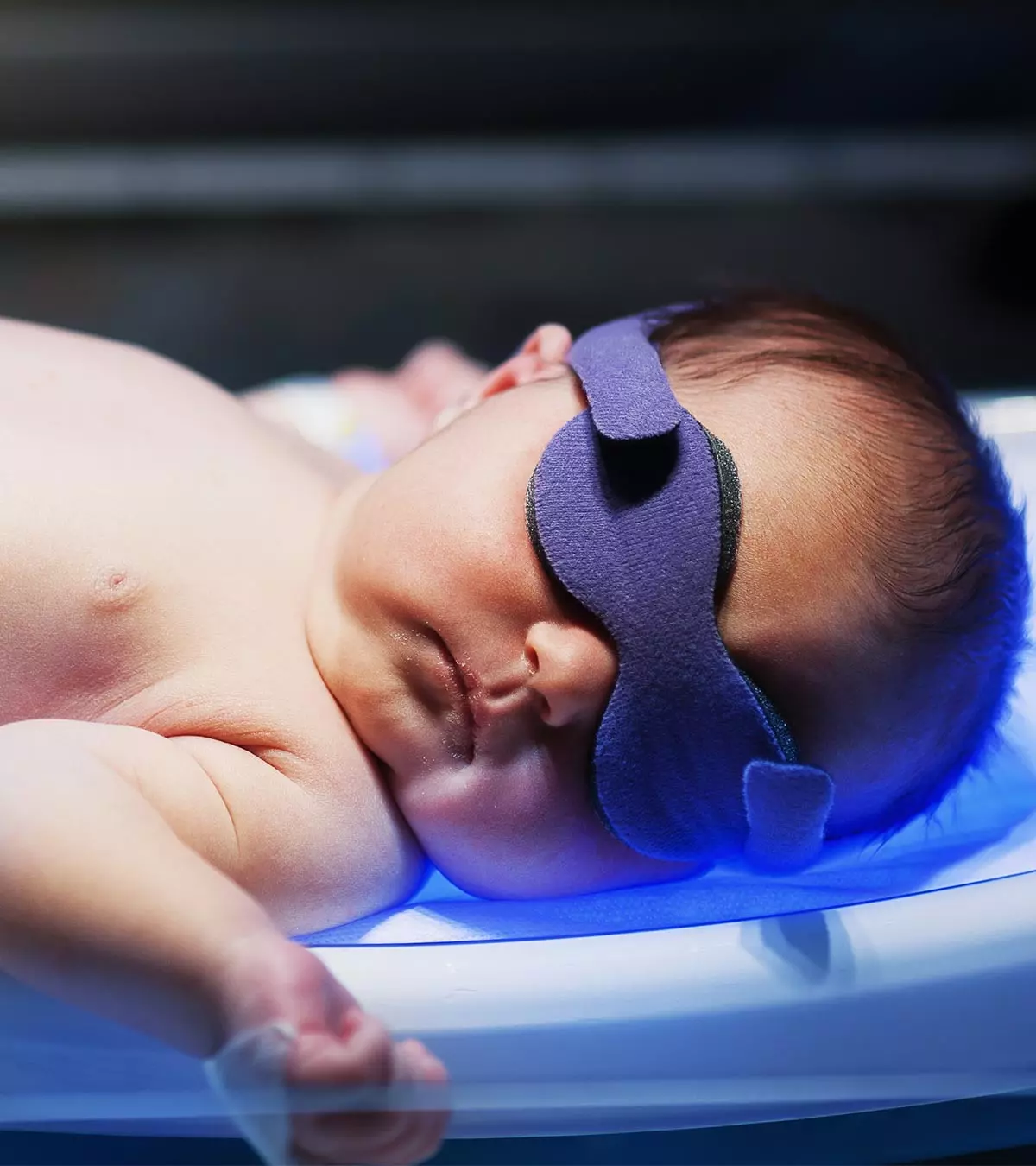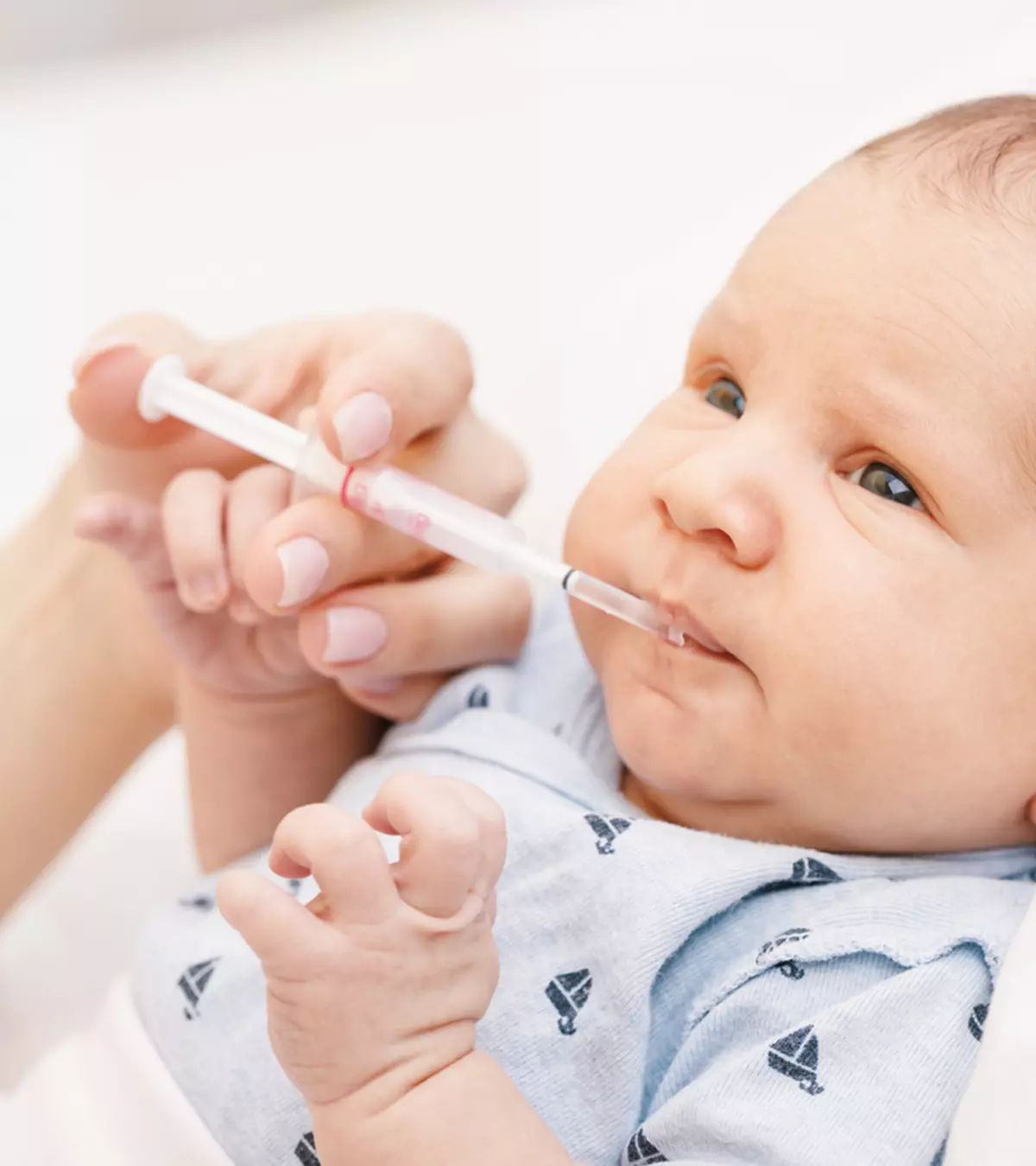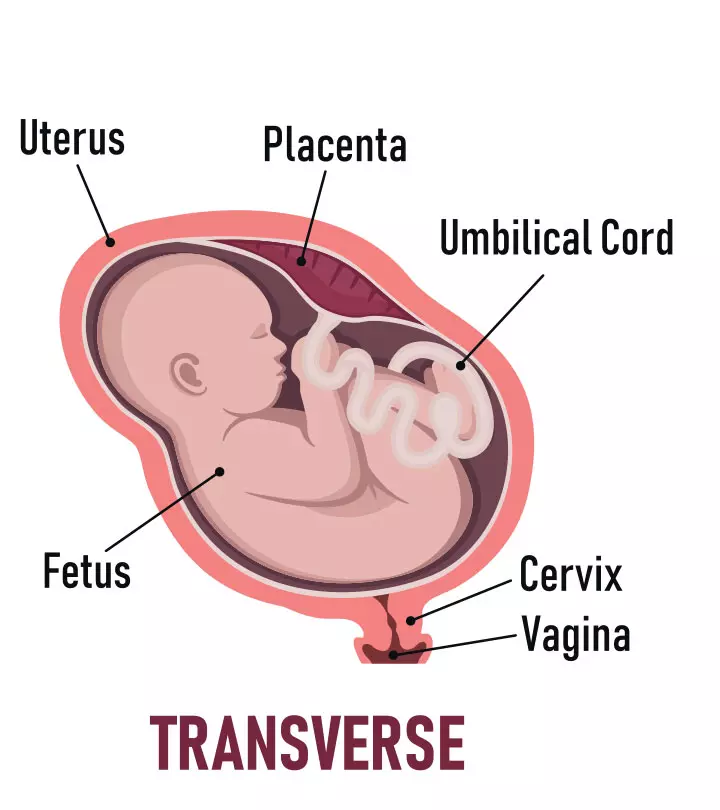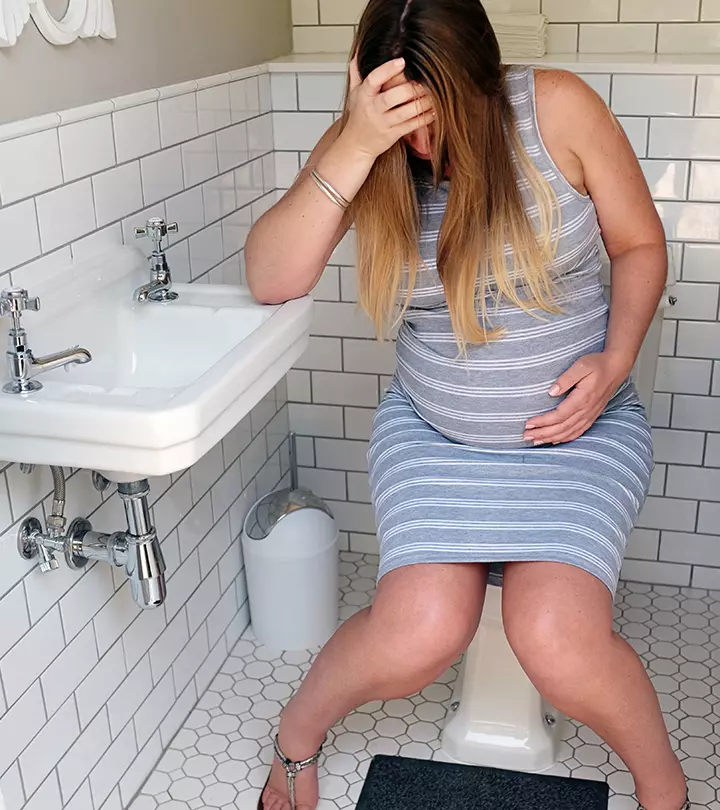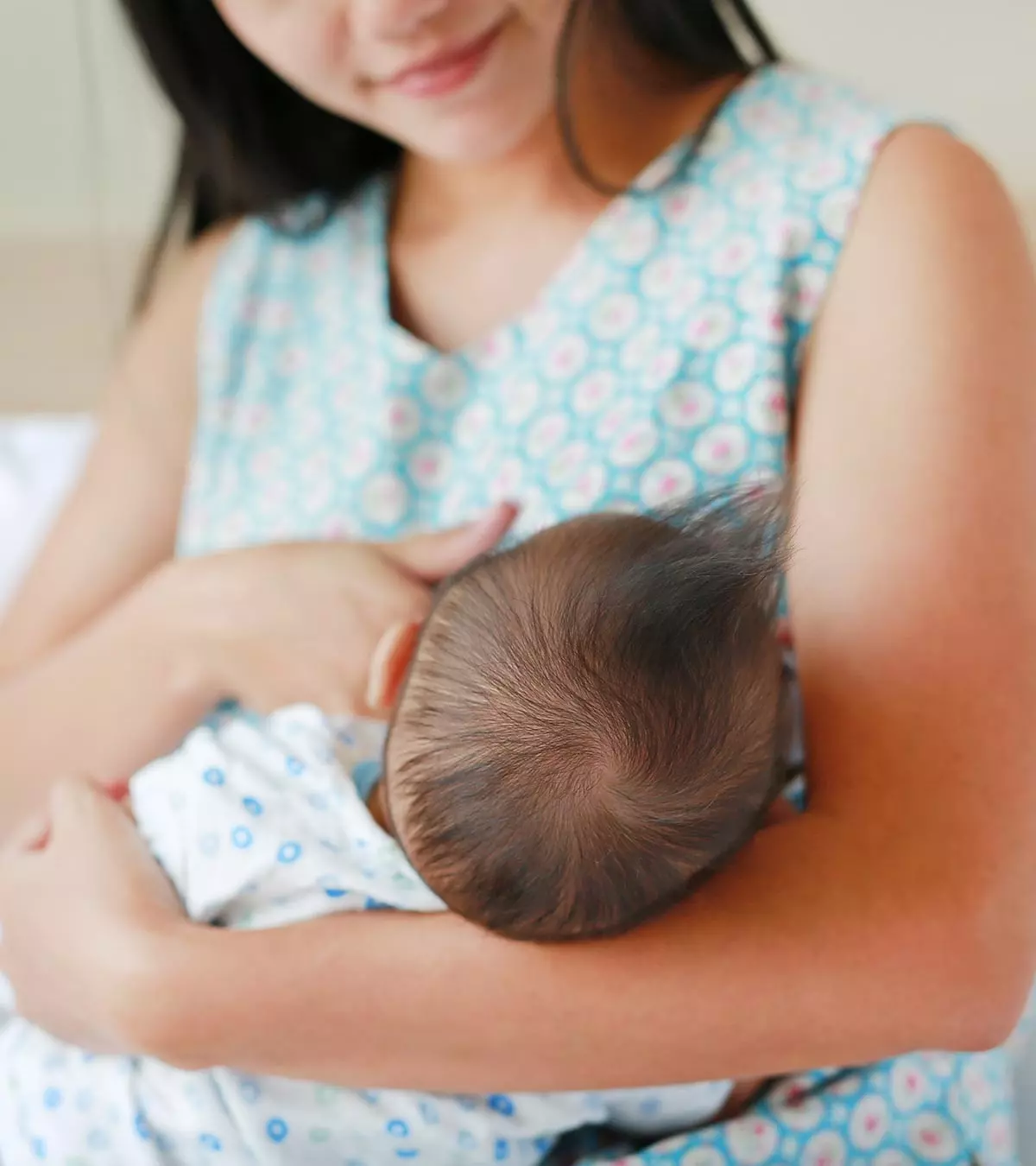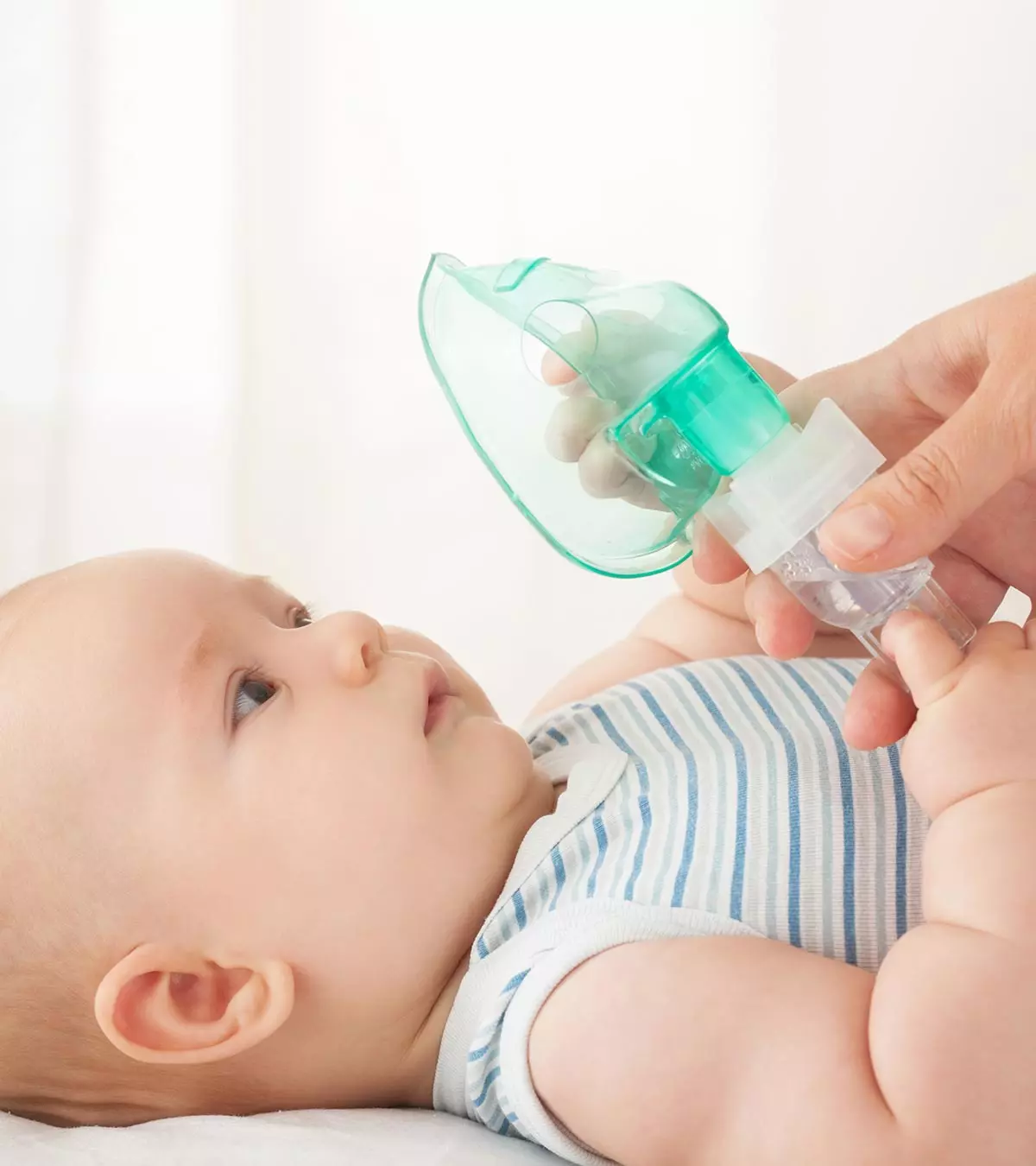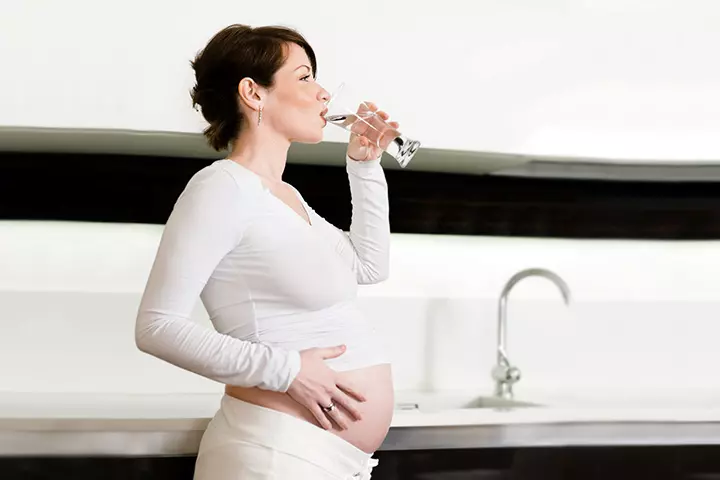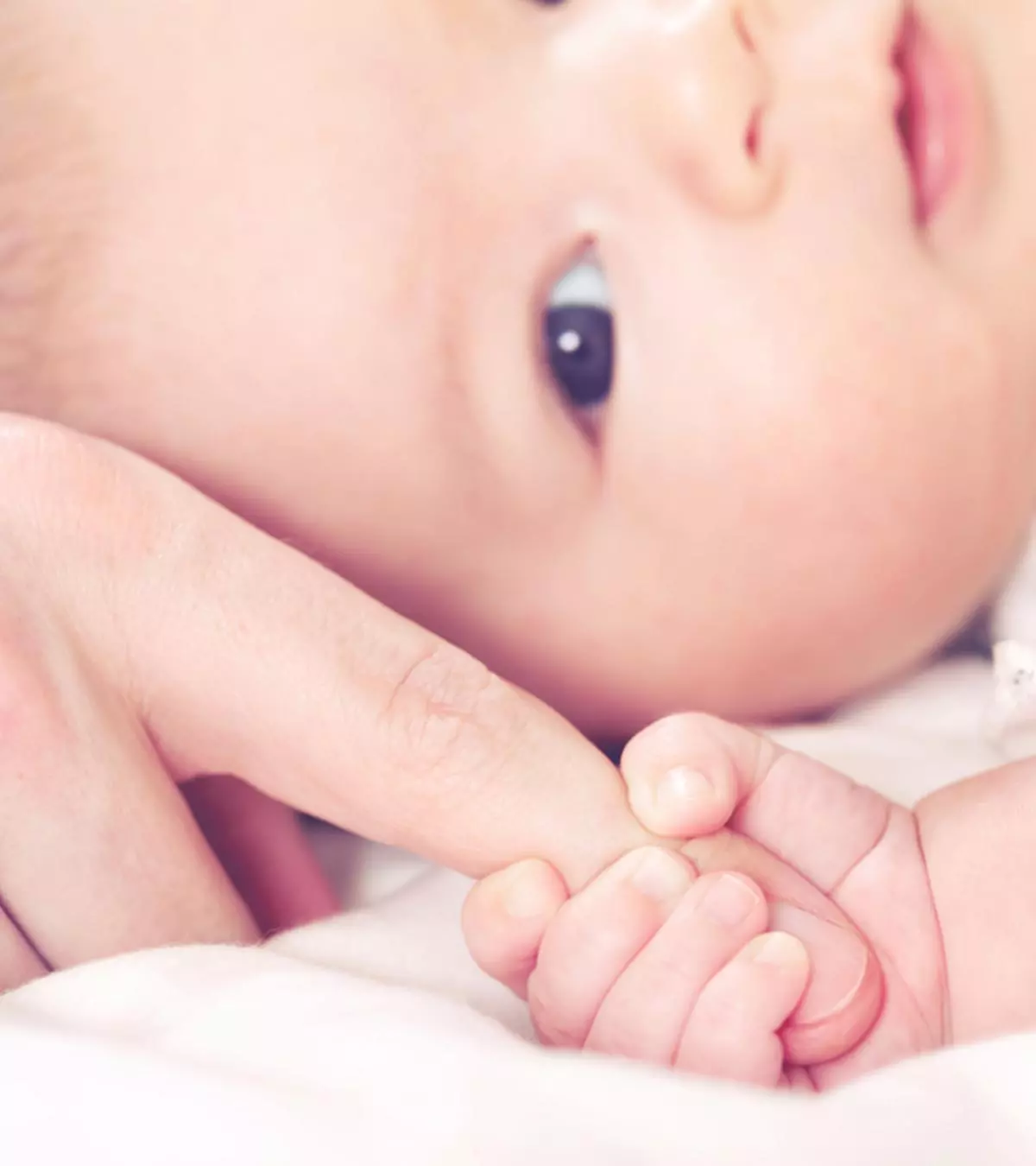
Image: Shutterstock
A reflex is an involuntary reaction or movement to a stimulus. Grasping reflex in babies is an innate reflex that involves the involuntary actions of fingers (1). For instance, when you give them your finger or an object, they try to clench or grasp it. Most responses of newborns and infants are reflexive in nature. These reflexes are known as primitive reflexes, infantile reflexes, or newborn reflexes. Reflexes indicate the brain and nervous system functioning and aid in fine and gross motor development.

In this post, we explain the grasping reflex, its significance, when it typically disappears, and when to be concerned about it.
Key Pointers
- The grasping reflex is an involuntary action of babies wrapping their fingers around objects.
- The brain and spinal cord control the grasping reflex and indicate a healthy central nervous system.
- Absence of grasp reflex beyond a certain age may indicate issues in the central nervous system.
What Is The Grasping Reflex?
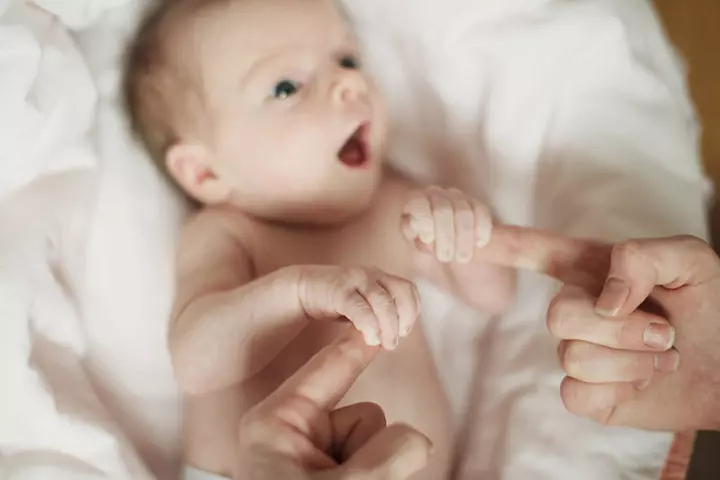
The grasping reflex is an involuntary action in which a baby wraps their fingers around your finger or an object that strokes their palm. It is an innate, primitive response of newborn babies to a mechanical stimulus (2).
The grasping reflex is also called the palmar reflex, palmar grasp reflex, or Darwinian reflex. You can examine the reflex by first placing your baby on their back (supine position) when they are awake and alert. The examiner needs to stroke the infant’s palm with the index finger. You will notice the following two stages of the reflex (3).
- Closing of fingers: The baby’s fingers undergo flexion to enclose the examiner’s finger.
- Clinging to the object/finger: The pressure applied to the palm produces traction on the fingers’ tendons, resulting in a clinging action. It could be difficult for you to pull out your finger gently at this stage since the baby would have a firm grip.
 Quick fact
Quick factPalmar Grasp Reflex vs. Plantar Grasp Reflex

Grasping reflex usually refers to the palmar reflex, which occurs on stimulation of the palm. However, a similar reflex can be elicited from the soles and toes. When the reflex occurs on the feet, it is called a plantar reflex, plantar grasp reflex, or Babinski reflex in babies.
Below are the notable differences between the palmar and the plantar grasp reflex (3) (4).
| Palmar Reflex | Plantar Reflex |
|---|---|
| Palmar reflex is seen on the hands. | Plantar reflex is seen on the feet. |
| Palmar reflex is also known as Darwinian reflex or grasping reflex. | Plantar reflex is also known as Babinski reflex. |
| The reflex causes the baby to wrap their fingers around the object or finger stroking the palm. | The reflex causes the big toe to curl upward and backward while other toes fan out when the sole is stroked from the heel to the toes. |
| Palmar reflex is seen from four months of gestation to six months after birth. | Plantar reflex is seen up to 9-12 months but may persist in some babies for up to 24 months. |
Significance Of The Grasping Reflex

The original purpose of the grasping reflex is unknown. The reflex is believed to be vestigiali since it may have been significant for our arboreali, primitive ancestors. Nevertheless, the reflex may make it easier for a newborn to embrace the environment. Newborns cannot organize movements to seize an object voluntarily. Therefore, the palmar reflex creates a basic motor pattern for easier interaction with various objects.
The grasping reflex is controlled by regions of the brain and the spinal cord. A healthy grasping reflex, along with other primitive reflexes, is often considered a positive indicator of good central nervous system (CNS) and the peripheral nervous system (nerves from the brain and the spinal cord) health (2).
Age Range Of The Grasping Reflex
The grasping or palmar reflex appears during the 16th week of gestation or second trimester. The reflex may be visible during ultrasound scans with the baby grasping the umbilical cord. The grasping reflex is usually visible up to six months of age, and it may disappear by five months in some infants (5). Premature babies usually have this reflex at the same time as full-term babies are expected to.
Why Does The Grasping Reflex Disappear?
The grasping reflex disappears due to reflex integration by the higher brain centers (6). Reflex integration occurs when mature brain centers inhibit the reflex and modify it to become a voluntary action. This indicates the maturation of a baby’s motor cortex (a part of the cerebral cortexiOuter covering of the brain tissues required for crucial neurological functions such as learning, memorizing, and critical thinking that controls movement). A mature motor cortex leads to better motor skills and the ability to perform voluntary actions. Thus, as the baby grows older, they do not need primitive reflexes since their nervous system is mature enough to perform vital actions voluntarily.
What If A Baby Does Not Have A Grasping Reflex?
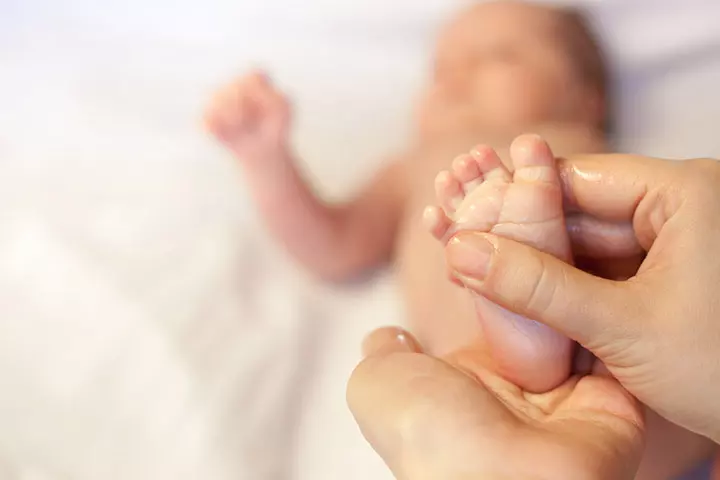
The absence of grasping reflex in newborns could indicate an underlying abnormality within the central nervous system or the peripheral nervous system. The following problems and issues could lead to an absent grasping reflex (2).
- Injury to the brain
- Injury to the spinal cord
- Damage to the nerves (peripheral nervous system)
- Prolonged compression and subsequent damage to the nerves
- Accidental head injuries or severe concussions during the newborn phase
The baby may display a weak palmar grasp reflex if they have movement disorders, such as cerebral palsy. Your baby’s doctor will assess the presence of the reflex at birth or during subsequent checkups. If your baby suddenly stops having a grasping reflex, consult your doctor promptly.
What If The Grasping Reflex Persists?
The retention of primitive reflexes, such as the grasping reflex, beyond the normal age range indicates failure of reflex integration by the higher brain centers. Below are some of the neurological problems and conditions that could cause the persistence of grasping reflex beyond six months (7).
- Spastic cerebral palsyiMuscular disorder characterized by increased muscle tone, resulting in stiff and jerky movements
- Neuromuscular disorders, such as spastic hemiplegiaiA neuromuscular disorder where the region of the brain controlling movements is impaired
- Cortical lesions, such as due to brain injuries
- Diminished cortical activity due to injury or severe illness
Many of these conditions cause other symptoms, and they may be diagnosed as the baby grows older. Speak to a pediatrician if your baby continues to have a grasping reflex after six months of age.
 Quick fact
Quick factOther Newborn Reflexes
Below are some of the other primitive reflexes present in newborns (8) (9) (10).
- Asymmetrical tonic neck reflex (ATNR): It is also known as the fencing reflex. When the baby is placed on the back, their head will turn with the arm and leg of one side extended. In the meantime, the other arm and the leg will be flexed. This reflex disappears by the age of seven months.
- Moro reflex: It is also known as the startle reflex. This sensory reflex causes a baby to throw their head backward while extending their arms and legs when they hear a loud sound or experience a sudden movement. The Moro (startle) reflex in babies lasts for up to two to six months.
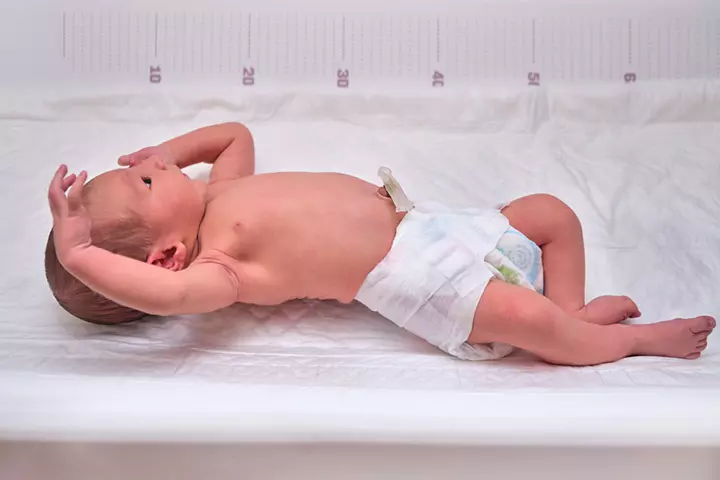
- Rooting reflex: If the newborn’s cheek is stroked, the baby will automatically open the mouth and turn their head towards the side that was stroked. This reflex helps the baby find and latch to the breast or bottle nipple. The rooting reflex in babies lasts up to four to six months.
- Stepping reflex: Hold the baby upright with the soles touching the ground. The baby begins to shift the feet one after the other, resembling the stepping action. The step reflex in babies disappears by the age of two to three months.
- Sucking reflex: If the baby’s palate (mouth’s roof) and lips are touched with a finger, nipple, or pacifier, the baby starts making sucking motions. The baby sucking reflex usually disappears by four months.
Frequently Asked Questions
1. Why are reflexes important for babies?
Primitive reflexes in the newborn facilitate survival. They are involuntary motor responses (movements) that are important in tracking normal brain and nerve activity as the child grows (11).
2. Do all babies have a grasp reflex?
All babies should ideally have a grasp reflex from birth to five to six months of age (10).
3. What can parents do to stimulate their baby’s grasping reflex?
Some activities may help develop grasping in babies (12):
- Stroking the outer edge of the hand from the little finger to the wrist may stimulate the opening of a closed hand.
- Placing an object in the baby’s hand and bending their fingers around it. Then, gently clutch at the object or twist it.
- Try placing colorful toys, rattles, and bells on the baby’s hand to encourage grasping or snatching the object.
4. Are babies grabbing their feet a milestone?
Babies grabbing their feet is a motor milestone that usually happens around four to six months as your baby gets accustomed to body movements. Since the action involves folding their bodies from the middle, it helps babies organize their movements. Moreover, as children bring their feet up, their gaze turns down to look at them, thus, improving vision and focus (13).
The grasping reflex in babies is the primitive involuntary response that also positively indicates your baby’s healthy central nervous system (CNS) and the peripheral nervous system. This reflex occurs even before birth from the 16th week of gestation; however, it eventually disappears as your baby’s motor cortex matures. Any birth injury to the brain, spinal cord, or nerves, as well as concussions, can result in the absence of the gripping reflex. If you observe any problem with the grasping reflex in your baby or it persists for too long, consult a pediatrician.
Infographic: Things To Know About Grasping Reflex In Babies
A baby develops a palmar or grasping reflex from the mother’s womb since the 16th week of gestation. It persists until the baby is six months old. However, the absence of this primitive response before six months and its presence after six months could indicate an underlying issue, as mentioned in the infographic below.
Some thing wrong with infographic shortcode. please verify shortcode syntax
Illustration: Grasping Reflex In Babies: Palmar vs Plantar And Age Range

Image: Stable Diffusion/MomJunction Design Team
References
1. Infant reflexes; U.S. National Library of Medicine
2. Aabha A. Anekar and Bruno Bordoni, Palmar Grasp Reflex; U.S. National Library of Medicine
3. Yasuyuki Futagi, Yasuhisa Toribe, and Yasuhiro Suzuki, The Grasp Reflex and Moro Reflex in Infants: Hierarchy of Primitive Reflex Responses; U.S. National Library of Medicine
4. Babinski reflex; U.S. National Library of Medicine
5. Newborn Reflexes; American Academy of Pediatrics
6. Primitive Motor Reflexes & Their Impact on a Child’s Function; Tools to Grow
7. Samuel R. Falkson and Bruno Bordoni, Grasp Reflex; U.S. National Library of Medicine
8. Newborn Reflexes; Stanford Children’s Health
9. Gabriela Beltre and Magda D. Mendez, Child Development; U.S. National Library of Medicine
10. Newborn reflexes; Healthy children
11. Alexa K. Modrell and Prasanna Tadi; Primitive Reflexes; NCBI
12. Activities to Help Develop Gripping, Reaching, and Hand‑Eye Coordination; Hesperian Health Guides
13. Parents’ guide to the importance of baby reaching hands to feet; Pathways
Community Experiences
Join the conversation and become a part of our nurturing community! Share your stories, experiences, and insights to connect with fellow parents.
Read full bio of Dr. Jessica Madden
Read full bio of Dr. Meenakshi Maruwada
Read full bio of Rohit Garoo
Read full bio of Ghazia Shah







